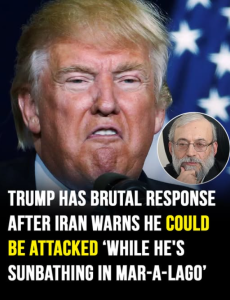🇮🇷 Iran’s Threat: Micro‑Drone at Mar‑a‑Lago
On July 9, 2025, Mohammad‑Javad Larijani, a senior adviser to Iran’s Supreme Leader Ayatollah Khamenei, made remarks on Iranian state television targeting Donald Trump. In a tone that mixed jest with menace, Larijani stated:
“Trump has done something so that he can no longer sunbathe in Mar‑a‑Lago. As he lies there with his stomach to the sun, a small drone might hit him in the navel. It’s very simple.”
The comment resonated across international media and social platforms, raising alarms over Tehran’s intentions and Iran’s growing drone capabilities showcased in conflicts like Ukraine. Analysts note this was more than mere rhetoric, referencing Iran’s earlier threats, including a 2022 animated video depicting Trump’s assassination and a 2023 fatwa by an Iranian cleric calling for Trump’s death.
🎯 Trump’s Response: Brushing It Off
Within hours, Trump dismissed the threat during a White House press conference:
-
He laughed off the claim, saying he hasn’t sunbathed seriously since age seven and joked he’s “not too big into it.”
-
Asked whether he considered the comment a real threat, Trump replied: “I guess it’s a threat. I’m not sure it’s a threat, actually, but perhaps it is.”
While publicly downplaying the seriousness, this response highlights Trump’s tried-and-true rhetorical style—mixing bravado with ambivalence.
📡 Context: Why Now?
1. Recent Military Strikes on Iran
In June 2025, Trump ordered U.S. strikes on three Iranian nuclear sites in coordination with Israel, aiming to slow Tehran’s advancing programThese attacks prompted sharp responses from Iran—including symbolic missiles at U.S. bases in Qatar—and followed a brief “12‑Day War” involving Iran, Israel, and U.S. proxy forces.
2. Fatwa & Fundraising Campaigns
Days before the drone threat, Grand Ayatollah Naser Makarem Shirazi issued a fatwa naming Trump an “enemy of God,” calling for his execution under Islamic law. Additionally, Iran International reported a platform raising over $40 million—dubbed “Blood Pact”—pledging bounties to those who kill enemies of Iran’s Supreme Leader
3. Drone Warfare Capabilities
Iran’s development of drone technology—particularly the Shahed series used in Ukraine—gives gravity to Larijani’s statement. The threat underscores Tehran’s willingness to use asymmetrical warfare tools.
🔍 Strategic Implications
A. From Rhetoric to Reality
While Larijani claimed to speak “like men,” stating Iran would not “fight dishonorably, the invocation of drone assassination represents a sharp escalation from past verbal rhetoric.
B. U.S. Domestic Security Response
The U.S. Department of Homeland Security and FBI reportedly increased counterterrorism efforts after the threat, focusing on sleeper cells linked to the IRGC operating in both the U.S. and the U.K.—MI5 has already foiled 15 Iran-linked plots in the U.K.
C. Diplomatic Fallout
This incident complicates nascent diplomatic dialogue between the U.S. and Iran. In March, Trump sent a letter to Khamenei suggesting talks, which Iran responded to via Oman mediation. Iran previously expressed openness to dialogue but rejected U.S. nuclear threats. The drone threat injects fresh volatility into these fragile negotiations.
D. Allied Reactions
Israel and European allies are watching closely. Europe continues to pressure Iran over its nuclear ambitions, while Israel stands to support Trump’s tough stance.
📝 What Comes Next?
1. Intelligence & Security Scaling
Expect heightened vigilance by U.S. and allied intelligence agencies. The Secret Service, DHS, FBI, and MI5 will likely track Iranian assets and monitor potential threats.
2. Diplomatic Ramifications
Western powers may tighten sanctions or pursue measures targeting individuals behind the threat. U.S. officials have already sought sanctions against Iranian clerics and funders of violence.
3. Voter & Political Impact
This threat arrives amid Trump’s pre‑2026 campaign buildup. It could bolster his narrative of being a target of global adversaries—or contrast with perceived security risks. It remains to be seen how public reaction aligns.
4. Iran’s Longer Game
Iran appears to be leveraging hybrid tactics—rhetoric, drone warfare capability, proxy actions—while staying below full-scale conflict. This strategy aims to deter U.S. aggression and rally domestic hardliners.
🧭 Final Thoughts
-
Larijani’s threat marks a dramatic rhetorical escalation in Iran‑U.S. relations—drone assassination talk is serious, even if couched in a jesting tone.
-
Trump’s response was defiant but dismissive, playing to his persona while revealing underlying concerns about personal safety.
-
The broader context involves military strikes, drone proliferation, religious edicts, and funding campaigns—all signaling an increasingly volatile phase in strategic competition.
-
The fallout may accelerate intelligence and diplomatic action, impact U.S. politics, and test the resilience of back‑channel diplomacy.
Stay tuned as deeper intelligence reviews emerge, allied coordination ramps up, and U.S.–Iran relations continue to ripple outward from this shocking Mar-a-Lago moment.

